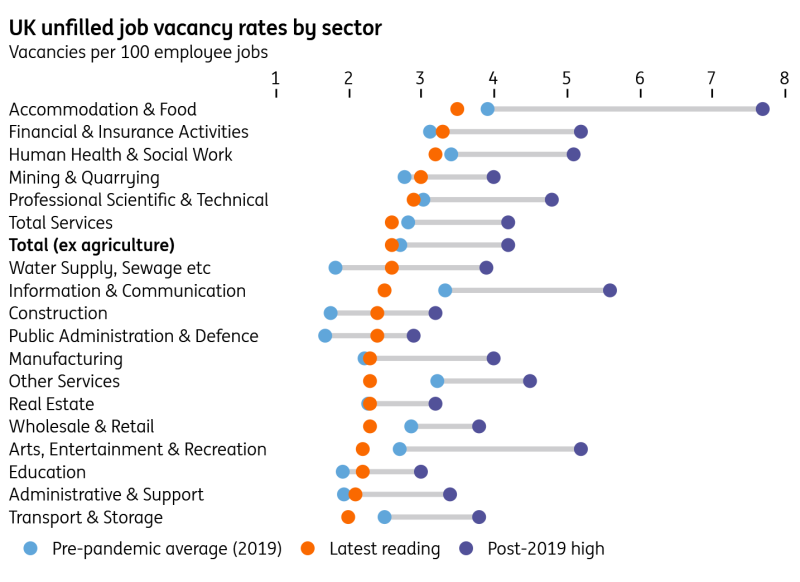UK wage growth appears stuck in the 4.5-5% area, despite falling private sector employment and lower vacancy rates. Further declines in wage growth are coming, but not immediately. For the time being, the Bank of England will remain cautious.
There’s one number that will catch the UK’s headlines this morning, and that’s the surprise surge in the unemployment rate from 4.0% to 4.3%. That’s a sizable rise and much bigger than anyone had anticipated. It’s also unusual because this number is based on three-month moving averages, which tends to dampen the volatility in this data.
In reality, of course, this tells us very little. The Office for National Statistics readily concedes that these figures suffer from well-known reliability problems. Indeed, all this rise really does is reverse an equally strange dip in the unemployment rate from earlier in the summer.
That’s not to say the jobs market isn’t cooling – it undoubtedly is. With one or two notable exceptions, the vacancy rate in the majority of sectors is comfortably below pre-Covid levels. If we look at internationally comparable data from Indeed, the hiring agency, this isn't a trend that’s been repeated so far – at least not as dramatically – in the US, Germany or France.
UK vacancy rates are generally below pre-Covid levels
Source: Macrobond, ING calculations
It’s a similar story with data taken from firms’ payrolls. Strip out sectors with a high concentration of public sector roles, and the number of payrolled employees has fallen by 0.8%, or 160,000, since the turn of the year.
These aren’t huge numbers, nor do these represent rapid changes in trend or the classic signs of recession. Redundancy levels are still very contained, for instance.
Still, against that backdrop, it’s surprising that wage growth is still as strong as it is. Private sector wage growth is close to 5% year-on-year. That measure is likely to tick higher over the next few months due to unfavourable base effects. Even if we look at more timely measures of wage growth, like the change compared to three months ago, these are still consistent with annual rates of roughly 4.5%. The Bank of England’s ‘Decision Maker’ survey of corporates has also seen the expected level of wage growth level out at around 4%. We think it’ll take until the second quarter of next year for the official private sector wage growth numbers to fall below that level.
Excluding government-heavy sectors, payrolled employment has fallen this year
Source: Macrobond, ING calculations
What does this all mean for the Bank of England? Given how far the jobs market has cooled, there’s nothing here that should stop officials from cutting rates to a much more neutral position. To our mind, that means rates in the 3-3.5% area. Markets are pricing fewer than three rate cuts now over the next two years, which we think is too little.
For now, though, both wage growth and services inflation are likely to remain sticky into year-end and early next year. Barring any surprises, we think the Bank will stay cautious and keep rates on hold in December, before cutting again in February. Assuming the data looks a little better by then, we think rate cuts will accelerate thereafter.
Read the original analysis: UK wage growth remains sticky despite cooling jobs market
Content disclaimer: This publication has been prepared by ING solely for information purposes irrespective of a particular user's means, financial situation or investment objectives. The information does not constitute investment recommendation, and nor is it investment, legal or tax advice or an offer or solicitation to purchase or sell any financial instrument. Read more here: https://think.ing.com/content-disclaimer/
Recommended Content
Editors’ Picks

EUR/USD stays near 1.0400 in thin holiday trading
EUR/USD trades with mild losses near 1.0400 on Tuesday. The expectation that the US Federal Reserve will deliver fewer rate cuts in 2025 provides some support for the US Dollar. Trading volumes are likely to remain low heading into the Christmas break.

GBP/USD struggles to find direction, holds steady near 1.2550
GBP/USD consolidates in a range at around 1.2550 on Tuesday after closing in negative territory on Monday. The US Dollar preserves its strength and makes it difficult for the pair to gain traction as trading conditions thin out on Christmas Eve.

Gold holds above $2,600, bulls non-committed on hawkish Fed outlook
Gold trades in a narrow channel above $2,600 on Tuesday, albeit lacking strong follow-through buying. Geopolitical tensions and trade war fears lend support to the safe-haven XAU/USD, while the Fed’s hawkish shift acts as a tailwind for the USD and caps the precious metal.

IRS says crypto staking should be taxed in response to lawsuit
In a filing on Monday, the US International Revenue Service stated that the rewards gotten from staking cryptocurrencies should be taxed, responding to a lawsuit from couple Joshua and Jessica Jarrett.

2025 outlook: What is next for developed economies and currencies?
As the door closes in 2024, and while the year feels like it has passed in the blink of an eye, a lot has happened. If I had to summarise it all in four words, it would be: ‘a year of surprises’.

Best Forex Brokers with Low Spreads
VERIFIED Low spreads are crucial for reducing trading costs. Explore top Forex brokers offering competitive spreads and high leverage. Compare options for EUR/USD, GBP/USD, USD/JPY, and Gold.

